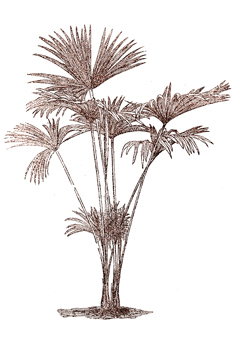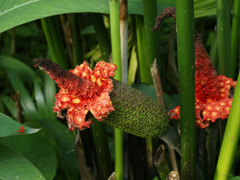 |
|
https://edibleplants.org/ |
 |
| Hans Hillewaert wikimedia.org |
Translate this page:
Summary
Panama Hat Plant or Carludovica palmata is a palm-like evergreen shrub that grows up to 3-4 m tall and found in Western South America. The leaves are fan-shaped and form into clusters. Edible parts are the young leaves and shoots, fruits, and roots. The stem yields strong, flexible, and durable fibre used for making Panama hats, cigar cases, small bags, mats, etc. The leaves are used as thatch and made into brooms. There is no known medicinal use of this plant. Other Names: "palm", Bombonassa, jipipapa, Toquilla, Chapeu-panama, Pumpuna. Spanish: bombonaje; carludovica; palma de sonbreroros (Mexico). French: carludovique. Cuba: jipijapa. Germany: Panama-Palme. Italy: carludovica.
Physical Characteristics

 Carludovica palmata is an evergreen Perennial growing to 2 m (6ft) by 2 m (6ft) at a fast rate.
Carludovica palmata is an evergreen Perennial growing to 2 m (6ft) by 2 m (6ft) at a fast rate.
See above for USDA hardiness. It is hardy to UK zone 10.
Suitable for: light (sandy), medium (loamy) and heavy (clay) soils and prefers well-drained soil. Suitable pH: mildly acid, neutral and basic (mildly alkaline) soils and can grow in very acid and very alkaline soils.
It can grow in semi-shade (light woodland) or no shade. It prefers moist soil.
UK Hardiness Map
US Hardiness Map
Synonyms
Plant Habitats
Edible Uses
Edible Parts: Flowers Fruit Leaves Root Shoots
Edible Uses: Condiment
Edible portion: Young flower, Leaves, Leafstalk, Fruit, Rhizome, Root. Young leaves and shoot tips - raw. Eaten in salads, they are said to have the flavour of asparagus[ 301 ]. Inner portions of lower leafstalks[ 301 ]. Fruit[ 301 ]. A red, slightly sweet pulp[ 416 ]. The fruit contains calcium oxalate crystals[ 416 ], which can give a sensation in the mouth of lots of small needles being stuck into the skin[ K ]. Roots - raw or cooked[ 301 ]. Added to salads or cooked as a potherb[ 301 ]. Young inflorescences[ 301 ].
References More on Edible Uses
Medicinal Uses
Plants For A Future can not take any responsibility for any adverse effects from the use of plants. Always seek advice from a professional before using a plant medicinally.
None known
References More on Medicinal Uses
The Bookshop: Edible Plant Books
Our Latest books on Perennial Plants For Food Forests and Permaculture Gardens in paperback or digital formats.

Edible Tropical Plants
Food Forest Plants for Hotter Conditions: 250+ Plants For Tropical Food Forests & Permaculture Gardens.
More

Edible Temperate Plants
Plants for Your Food Forest: 500 Plants for Temperate Food Forests & Permaculture Gardens.
More

More Books
PFAF have eight books available in paperback and digital formats. Browse the shop for more information.
Shop Now
Other Uses
Broom Fibre Thatching Weaving
Other uses rating: High (4/5). Other Uses: A fibre is obtained from the stems. It is used for making Panama hats, cigar cases, small bags, mats etc[ 46 , 302 , 454 ]. The fibre, or more properly narrow strips of the very young leaves, is notable for its strength, durability, and flexibility[ 311 ]. From it are made the well-known Panama hats in Central America 'sombreros de Jipijapa' which, despite their English name, are not made in Panama but in a restricted area of Ecuador where atmospheric conditions are particularly suitable for their handling[ 331 ]. The leaves are cut while young, and the stiff parallel veins removed, after which they are slit into shreds, but not separated at the stalk end, and immersed in boiling water for a short time and then bleached in the sun[ 454 ]. The leaves are split into two parts and used as thatch[ 302 , 521 ]. The whole leaf is used as an emergency umbrella in sudden downpours[ 521 ]. Used for making brooms[ 302 ]. Suitable for growing in containers.
Special Uses
References More on Other Uses
Cultivation details
A plant of the moist tropics, where it is found at elevations up to 800 metres. It grows best in areas where annual daytime temperatures are within the range 24 - 32°c, but can tolerate 12 - 37°c[ 418 ]. It prefers a mean annual rainfall in the range 1,200 - 1,800mm, but tolerates 800 - 2,200mm[ 418 ]. Succeeds in full sun, but prefers a shady position, growing well in the shade of trees[ 302 ]. Prefers a fertile, moist but well-drained soil. Prefers a pH in the range 5 - 6, tolerating 4.5 - 6.5[ 418 ]. When grown from seed, the first leaves are ready for harvesting after about 7 years[ 418 ]. If suckers are used, the leaves can be harvested after about 18 months, by which stage there will be about 20 - 30 leaves[ 418 ]. Suitable for growing in containers.
References Carbon Farming Information and Carbon Sequestration Information
Temperature Converter
Type a value in the Celsius field to convert the value to Fahrenheit:
Fahrenheit:
The PFAF Bookshop
Plants For A Future have a number of books available in paperback and digital form. Book titles include Edible Plants, Edible Perennials, Edible Trees,Edible Shrubs, Woodland Gardening, and Temperate Food Forest Plants. Our new book is Food Forest Plants For Hotter Conditions (Tropical and Sub-Tropical).
Shop Now
Plant Propagation
From seed; germinate in vitro in gelatin, agar or other medium. Seed Collecting: Remove fleshy coating on seeds before storing. Division from the root clump.
Other Names
If available other names are mentioned here
Panama Hat Plant or Carludovica palmata. Other Names: "palm", Bombonassa, jipipapa, Toquilla, Chapeu-panama, Pumpuna. Spanish: bombonaje; carludovica; palma de sonbreroros (Mexico). French: carludovique. Cuba: jipijapa. Germany: Panama-Palme. Italy: carludovica.
Native Range
SOUTHERN AMERICA: Belize, Costa Rica, Guatemala, Panama, Bolivia, Ecuador, Peru
Weed Potential
Right plant wrong place. We are currently updating this section.
Please note that a plant may be invasive in one area but may not in your area so it's worth checking.
May be a noxious weed or invasive. Some evidence it is invasive in Cuba.
Conservation Status
IUCN Red List of Threatened Plants Status : Status: Least Concern

Growth: S = slow M = medium F = fast. Soil: L = light (sandy) M = medium H = heavy (clay). pH: A = acid N = neutral B = basic (alkaline). Shade: F = full shade S = semi-shade N = no shade. Moisture: D = dry M = Moist We = wet Wa = water.
Now available:
Food Forest Plants for Mediterranean Conditions
350+ Perennial Plants For Mediterranean and Drier Food Forests and Permaculture Gardens.
[Paperback and eBook]
This is the third in Plants For A Future's series of plant guides for food forests tailored to
specific climate zones. Following volumes on temperate and tropical ecosystems, this book focuses
on species suited to Mediterranean conditions—regions with hot, dry summers and cool, wet winters,
often facing the added challenge of climate change.
Read More
Expert comment
Author
Ruiz & Pav.
Botanical References
Links / References
For a list of references used on this page please go here
A special thanks to Ken Fern for some of the information used on this page.
Readers comment
| Add a comment |
|
If you have important information about this plant that may help other users please add a comment or link below. Only comments or links that are felt to be directly relevant to a plant will be included. If you think a comment/link or information contained on this page is inaccurate or misleading we would welcome your feedback at [email protected]. If you have questions about a plant please use the Forum on this website as we do not have the resources to answer questions ourselves.
* Please note: the comments by website users are not necessarily those held by PFAF and may give misleading or inaccurate information.
To leave a comment please Register or login here All comments need to be approved so will not appear immediately.
|
Subject : Carludovica palmata
|
|
|
|